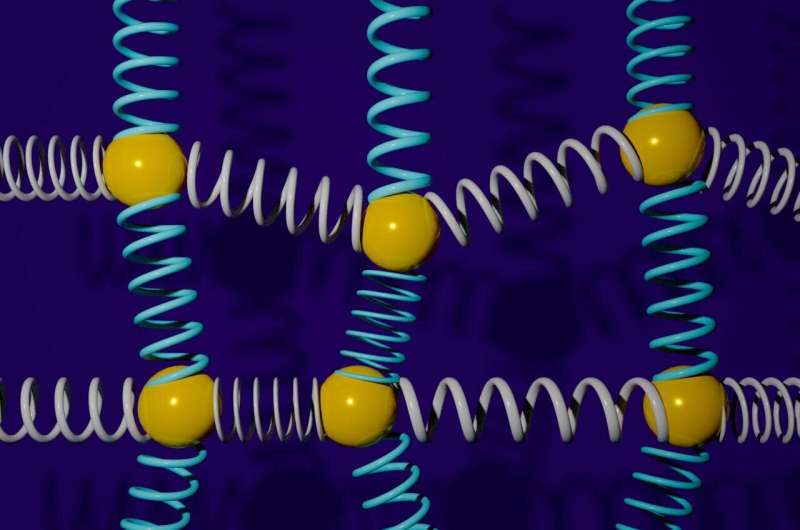The dynamics of coupled oscillators, like the one shown here, can be simulated much faster using new quantum algorithms.Image credit: Nathan Johnson | Pacific Northwest National Laboratory
Although “coupled oscillations” may sound unfamiliar, they are ubiquitous in nature. The term “coupled oscillator” describes an interacting system of masses and springs, but their uses in science and engineering don’t end there. They describe mechanical systems such as bridges, bonds between atoms, and even gravitational tidal effects between the Earth and the Moon. Understanding these questions enables us to explore a range of corresponding systems, from chemistry to engineering to materials science.
Coupled oscillatory systems are often represented by ball and spring models and become more and more complex as more oscillators are added. Pacific Northwest National Laboratory (PNNL) co-appointee and University of Toronto professor Nathan Wiebe has created a new quantum algorithm that can now simulate such complex coupled oscillator systems faster and more efficiently.These results were published in Physical ReviewX.
Working with researchers from Google Quantum Artificial Intelligence and Macquarie University in Sydney, Australia, Wiebe developed an algorithm for simulating a system of coupled masses and springs on a quantum computer. The researchers then provided evidence of the exponential advantages of the new algorithm over the classic algorithm.
This acceleration is achieved by mapping the dynamics of the coupled oscillator onto the Schrödinger equations, the quantum counterpart of the classical Newtonian equations. From there, the system can be simulated using the Hamiltonian method.
Essentially, this approach allows scientists to express the dynamics of coupled oscillators using far fewer qubits than traditional methods. Researchers can then simulate the system using exponentially fewer operations.
Perhaps the most interesting aspect of their work stems from the question of whether this algorithm indeed provides exponential speedups over all possible ordinary algorithms. First, the authors show that the algorithm works in both directions: coupled resonators can be used to simulate any quantum computer.
This means that, at a high level, very large systems of interacting masses and springs can contain the equivalent of computing power of a quantum computer.
Second, the authors consider the theoretical limitations of computing these dynamics. If there was a way to simulate these dynamics in polynomial time on existing computers, then researchers could build a faster way to simulate quantum computers. However, this would prove that quantum computers are not inherently more powerful than classical computers.
Evidence accumulated over the years suggests that classical computers are unlikely to be as qualitatively powerful as quantum computers. This work therefore provides a compelling argument that the algorithm provides exponential speedup and clearly demonstrates the novel and subtle connection between quantum dynamics and humble resonators.
“Few new classes of provable exponential acceleration of classical computation have been developed,” Wiebe said. “Our work provides significant computational advantages for a wide range of problems in engineering, neuroscience and chemistry.”
More information:
Ryan Babbush et al., Modeling Exponential Quantum Speedup in Coupled Classical Oscillators, Physical ReviewX (2023). DOI: 10.1103/PhysRevX.13.041041
Provided by Pacific Northwest National Laboratory
citation: Quantum computing drives simulations forward (2024, April 22), Retrieved April 22, 2024, from https://phys.org/news/2024-04-simulations-quantum.html
This document is protected by copyright. No part may be reproduced without written permission except in the interests of fair dealing for private study or research purposes. Content is for reference only.
#Quantum #computing #drives #simulation
Image Source : phys.org
